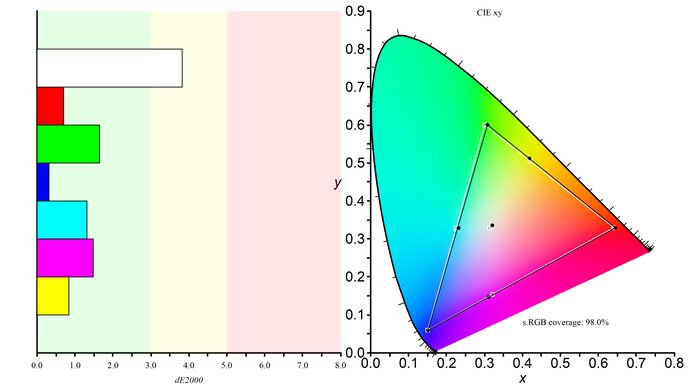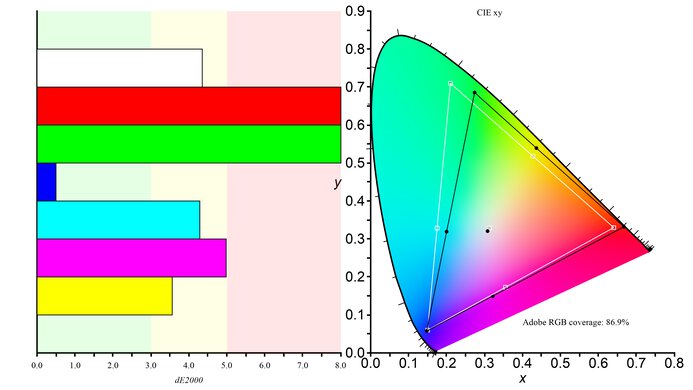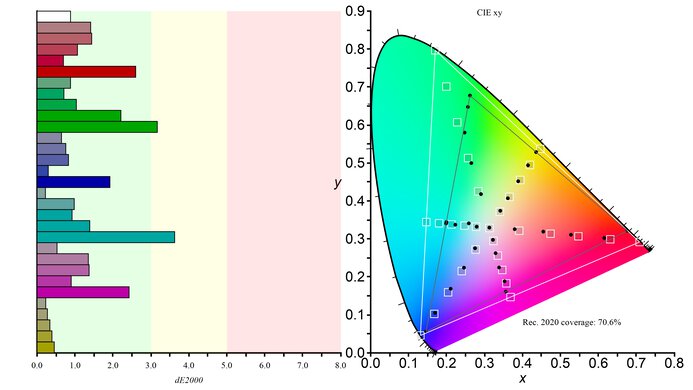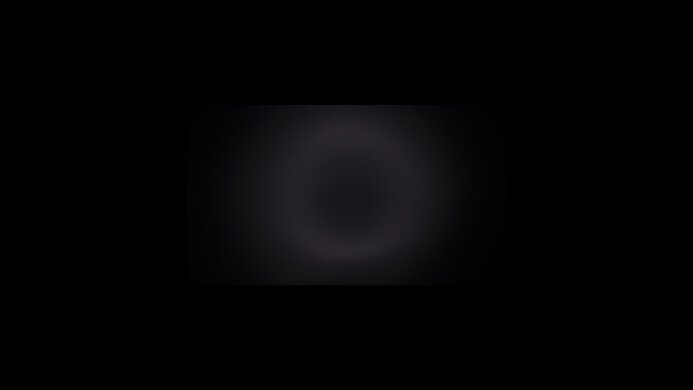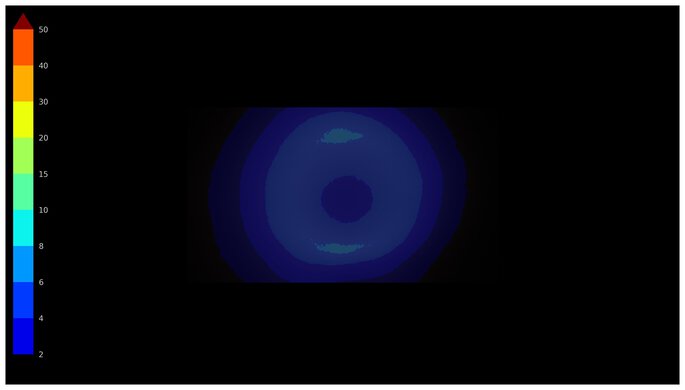The LG 27GS95QE-B is a 27-inch, 1440p gaming monitor with an OLED screen and is an update to the LG 27GR95QE-B, advertised to have higher brightness. Part of the LG UltraGear lineup alongside the ultrawide LG 34GS95QE-B, it has a 240Hz refresh rate, and thanks to its DisplayPort 1.4 port and HDMI 2.1 bandwidth, you can reach its maximum refresh rate with any type of connection. It also supports all common VRR types, including FreeSync and G-SYNC compatibility, to reduce screen tearing. Beyond its gaming performance, it also offers a remote to control the monitor from a distance, as well as a headphone output with DTS Headphone:X support for 3D sound and an optical audio output.
Our Verdict
The LG 27GS95QE-B is incredible for PC gaming. It offers a high 240Hz refresh rate with support for all common VRR types to reduce screen tearing. It also has low input lag for a responsive feel, and motion looks incredible thanks to its near-instantaneous response time. Additionally, it's a fantastic choice for dark room gaming as it displays perfect blacks without any blooming. Unfortunately, there's noticeable VRR flicker with changing frame rates, which can get distracting in dark scenes.
- Near-infinite contrast ratio.
- 240Hz refresh rate with VRR support.
- Exceptionally fast response time.
- Low input lag.
- Noticeable VRR flicker with changing frame rates.
The LG 27GS95QE-B is incredible for console gaming. It has HDMI 2.1 bandwidth, so it supports any signal from the PS5 and Xbox Series X|S, including downscaled 4k @ 120Hz signals, but it's still limited to a 1440p resolution. Gaming feels responsive thanks to its low input lag at any refresh rate, and it has outstanding motion handling. Luckily, your games also look realistic thanks to its excellent HDR picture quality with its deep blacks.
- Near-infinite contrast ratio.
- HDMI 2.1 bandwidth for console gaming.
- Exceptionally fast response time.
- Low input lag.
- Limited to 1440p resolution.
The LG 27GS95QE-B is decent for office use in certain circumstances. It has wide viewing angles and good ergonomics that make it easy to share the screen with a coworker or client, as they'll see a consistent image from the sides. It has great reflection handling and overcomes glare in most environments, but not extremely bright ones. Unfortunately, it has worse text clarity than other 27-inch, 1440p monitors, and its OLED panel is prone to burn-in with exposure to static elements over a long period.
- 27-inch screen.
- Wide viewing angles.
- Good ergonomics.
Great reflection handling.
- Some text clarity issues due to RWBG layout.
- Risk of burn-in.
- Can't fight really intense glare.
The LG 27GS95QE-B is excellent for content creators in certain circumstances. The 27-inch screen is big enough to open two windows next to each other. It also has wide viewing angles and good ergonomics if you often need to share your screen with coworkers or clients. Additionally, it has fantastic accuracy before calibration in the sRGB mode. On the downside, text clarity is just okay, as there's color fringing around text, and it's also prone to burn-in, which could be problematic with static elements.
- Wide viewing angles.
- Good ergonomics.
Great reflection handling.
- Near-infinite contrast ratio.
- Fantastic accuracy in sRGB mode.
- Some text clarity issues due to RWBG layout.
- Risk of burn-in.
- sRGB mode locks some settings.
The LG 27GS95QE-B has decent brightness. It's bright enough to fight glare in most rooms unless there are really bright light sources facing the screen. It also gets bright enough in HDR for small highlights to pop, but larger highlights are dimmer.
- Bright enough for most rooms.
- Can't fight really intense glare.
The LG 27GS95QE-B has a near-instantaneous response time, leading to exceptionally crisp motion.
- Exceptionally fast response time.
- Outstanding refresh rate compliance.
The LG 27GS95QE-B is remarkable for HDR. It displays deep blacks in dark rooms, and there isn't any blooming around bright objects either. It also displays a wide range of colors in HDR, but not all colors are bright and vivid.
- Near-infinite contrast ratio.
- No blooming around bright objects.
- Not all colors are bright and vivid in HDR.
The LG 27GS95QE-B has exceptional picture quality in SDR. It displays deep and inky blacks without any blooming, and it also displays a wide range of colors.
- Near-infinite contrast ratio.
- No blooming around bright objects.
The LG 27GS95QE-B has fantastic accuracy. It has a dedicated sRGB mode with incredible accuracy, but because it locks many picture settings, you may still want to calibrate it for the most customization.
- Fantastic accuracy in sRGB mode.
- sRGB mode locks some settings.
Performance Usages
Changelog
- Updated Nov 10, 2025: We've converted this review to Test Bench 2.1.1. We removed the Vertical Viewing Angle test.
-
Updated Jun 26, 2025:
We measured the Input Lag in the 'sRGB' Game Mode.
-
Updated Jun 13, 2025:
We updated text throughout to match the new and updated tests with Test Bench 2.1, including in the Verdict section.
- Updated Jun 13, 2025: We've converted this review to Test Bench 2.1. This includes new tests for Direct Reflections, Ambient Black Level Raise, and Total Reflected Light. You can see all the changes in the changelog.
Check Price
Differences Between Sizes And Variants
We tested the 27-inch LG 27GS95QE-B, which is the only size available for this monitor. The results are only valid for this model.
| Model | Size | Resolution | Panel Type | Refresh Rate | Firmware Version Tested |
|---|---|---|---|---|---|
| 27GS95QE-B | 27" | 1440p | OLED | 240Hz | 3.03, 2.02 |
Our unit was manufactured in December 2023; you can see a photo of the label here.
Popular Monitor Comparisons
The LG 27GS95QE-B is a fantastic gaming monitor that combines a fast 240Hz refresh rate with the incredible picture quality of an OLED. It's a great choice if you want the best of both worlds regarding picture quality and a smooth gaming experience, and it's a significant upgrade over the brightness and motion handling of the LG 27GR95QE-B. However, it has some drawbacks, as other monitors with a QD-OLED panel have higher refresh rates and brighter colors. If that's important to you, consider the Dell Alienware AW2725DF, which has a 360Hz refresh rate and more vivid HDR colors.
See our recommendations for the best 240Hz monitors, the best 1440p gaming monitors, and the best 27-inch gaming monitors.
The LG 27GS95QE-B and the ASUS ROG Strix OLED XG27AQDMG are very similar 27-inch OLED gaming monitors. The ASUS is a better option if you prefer the vividness of a glossy screen. The ASUS is also a better choice if you find VRR flicker distracting, as it has a setting to reduce this, though it causes some stutter. However, the LG is better if you prefer a more consistent display in different lighting conditions with its matte screen. It's also a better choice if you plan to use the Xbox Series X|S with your monitor, as it's more compatible with that console.
The MSI MPG 271QRX QD-OLED and the LG 27GS95QE-B are premium 27-inch gaming monitors. If vivid HDR colors are important to you, then the MSI is the better choice, as it has far more vibrant HDR colors.
The LG 27GS95QE-B and the Samsung Odyssey OLED G60SD S27DG602S are both 27-inch OLED gaming monitors. The Samsung is the better choice for most people. It has an option that significantly reduces VRR flicker while gaming, a higher refresh rate for a more responsive feel while gaming, more vivid colors in HDR, and clearer text. However, the LG is a better choice if you plan to use your monitor for console gaming, as it has outstanding compatibility with both consoles.
The Dell Alienware AW2725DF and the LG 27GS95QE-B are both 27-inch OLED gaming monitors. If you're in a brighter environment, the LG is a better choice as it has better SDR and HDR brightness, so it's better at fighting glare, and deep blacks don't appear purple in a brighter room, unlike the Dell. However, the Dell has a higher refresh rate for a smoother feel and more vibrant HDR colors for a more immersive gaming experience.

We buy and test more than 30 monitors each year, with units that we buy completely on our own, without any cherry-picked units or samples. We put a lot into each unbiased, straight-to-the-point review, and there's a whole process from purchasing to publishing, involving multiple teams and people. We do more than just use the monitor for a week; we use specialized and custom tools to measure various aspects with objective data-based results. We also consider multiple factors before making any recommendations, including the monitor's cost, its performance against the competition, and whether or not it's easy to find.
Test Results

The LG 27GS95QE has a gamer-oriented aesthetic with a stylish design. It features some RGB lighting along the vents.
The LG 27GS95QE has good ergonomics. You can adjust it in any way, but the swivel range is limited, and you can only rotate it into portrait mode counterclockwise, meaning the inputs will always be on the right side of the stand. Luckily, there's a clip on the stand for cable management to keep your setup clean.
The monitor's stand is solid, as there's minimal wobble, but it's big and takes up space. However, the V-shaped feet allow you to still place stuff like your keyboard and mouse between them.
The monitor has a remote to control the on-screen display, which is easier to use than traditional joysticks or buttons on monitors. There's a power button underneath the center of the monitor that also features RGB lighting next to it.
OLED panels like this one don't have a backlight, so they don't require a local dimming feature. However, with a near-infinite contrast ratio, there isn't any blooming around bright objects, and it's the equivalent of a perfect local dimming feature. We still film these videos on the monitor so you can see how the screen performs and compare it with a monitor that has local dimming.
The LG 27GS95QE has decent SDR brightness and gets bright enough to fight glare unless bright light sources are shining on it. These results are from after calibration in the 'sRGB' Picture Mode with the Brightness at its max, Peak Brightness at 'Low,' and Smart Energy Saving 'Off.' However, the lowest minimum brightness measurement is with Peak Brightness 'Off,' as it's 23 cd/m² when Peak Brightness is set to 'Low.'
The monitor has an automatic brightness limiter (ABL) that decreases brightness as more of the screen displays bright content. While the ABL makes the monitor brighter in most scenarios, it can cause fixed elements on your screen, like the white background in a Word document, to vary in brightness if content elsewhere on your screen changes. If you prefer a lower but more consistent screen brightness, you can turn Peak Brightness 'Off.' However, if you do this, the real scene brightness drops considerably to 199 cd/m². You can see the results with Peak Brightness turned 'Off' below:
- Peak 2% Window: 258 cd/m²
- Peak 10% Window: 258 cd/m²
- Peak 25% Window: 259 cd/m²
- Peak 50% Window: 259 cd/m²
- Peak 100% Window: 260 cd/m²
- Sustained 2% Window: 257 cd/m²
- Sustained 10% Window: 256 cd/m²
- Sustained 25% Window: 257 cd/m²
- Sustained 50% Window: 258 cd/m²
- Sustained 100% Window: 259 cd/m²
The HDR brightness is okay. It gets brightest with small highlights, and they stand out against the rest of the screen. The EOTF also follows the target PQ curve well, though it has an early roll-off, so highlights don't get the brightest they could. These results are from the 'Gamer 1' Picture Mode, with the Brightness at its max, Peak Brightness at 'Low,' and Smart Energy Saving turned 'Off.'
The monitor has an automatic brightness limiter (ABL), meaning the screen decreases in brightness with larger content. If you prefer consistent brightness across different content, you can turn Peak Brightness 'Off,' but that makes the screen dimmer, which you can see with the results below. You can also see the results with Peak Brightness set to 'High,' which gets much brighter but has a more aggressive ABL and a less accurate image.
| Window Size | Off | High |
| Real Scene | 224 cd/m² | 430 cd/m² |
| Peak 2% | 262 cd/m² | 1,267 cd/m² |
| Peak 10% | 260 cd/m² | 782 cd/m² |
| Peak 25% | 262 cd/m² | 446 cd/m² |
| Peak 50% | 263 cd/m² | 324 cd/m² |
| Peak 100% | 264 cd/m² | 263 cd/m² |
| Sustained 2% | 261 cd/m² | 1,157 cd/m² |
| Sustained 10% | 259 cd/m² | 766 cd/m² |
| Sustained 25% | 260 cd/m² | 445 cd/m² |
| Sustained 50% | 261 cd/m² | 322 cd/m² |
| Sustained 100% | 262 cd/m² | 263 cd/m² |
| ABL | 0.001 | 0.087 |
| EOTF | Chart | Chart |
The accuracy before calibration is incredible. The sRGB mode locks the colors well to the sRGB color space, and there are minimal inaccuracies with colors and the white balance. The color temperature is also very close to the 6500K target. However, gamma doesn't follow the sRGB curve in some places, as darker scenes are too dark, and brighter scenes are brighter than they should be. Unfortunately, using this accurate sRGB mode locks some picture settings, including Black Stabilizer and Gamma. If you want to adjust these settings, you can use the 'Gamer 1' Game Mode, though it's less accurate, with oversaturated colors and a brighter gamma.
The accuracy after calibration is excellent.
We couldn't fully calibrate this monitor, as the calibration software would crash when configuring the monitor in the 'Gamer 1' Game Mode, and the monitor would likely score better if this hadn't occurred. We calibrated it in the sRGB mode instead, though some picture settings are locked in this mode. As a result, we couldn't correct the white balance, so it's not as good as before calibration. Because of this, it's possible you can achieve even better accuracy if you don't experience this calibration issue.
The HDR color volume is good. It displays dark colors well, thanks to its near-infinite contrast ratio, but it struggles more with bright and vivid colors. If you want a monitor with more vivid colors, check out the MSI MPG 271QRX QD-OLED.
The horizontal viewing angle is remarkable. The image remains the same no matter where you view the screen from, which is great for co-op gaming.
The LG 27GS95QE has okay text clarity, but it's worse than other 27-inch, 1440p monitors. This is because of its RWBG subpixel layout, as computer programs don't render text properly with this layout. This results in some color fringing around text if ClearType is enabled. While it isn't the worst case of color fringing, it can be distracting if you're sitting close and notice text clarity issues easily.
Enabling Windows ClearType (top photo) can help improve the text clarity, but it can introduce color fringing. This means you must choose between sharper text with color fringing or worse text clarity without the fringing. These photos are with Windows 10, and you can see what it looks like in Windows 11 with ClearType on here, and with ClearType off here.
This monitor has impressive direct reflection handling. It has minimal direct reflections, as it spreads light out due to the matte coating.
The black levels are good in a bright room. Although it doesn’t have the same deep, inky blacks in a well-lit room, they don’t rise too much.
You can reach the monitor's max refresh rate over any connection, but your graphics card needs to support Display Stream Compression (DSC) for 10-bit signals over DisplayPort. You can disable DSC by changing the Input Compatibility Version to '1.4', but you can only do that over DisplayPort.
NVIDIA
VRR Min
VRR Max
DisplayPort
<20Hz
240Hz
HDMI
<20Hz
240Hz
AMD
VRR Min
VRR Max
DisplayPort
<20Hz
240Hz
HDMI
<20Hz
240Hz
On top of supporting FreeSync VRR and G-SYNC compatibility, this monitor also supports HDMI Forum VRR.
| Refresh Rate | CAD Heatmap | RT Chart | Pursuit Photo |
| 238 | Heatmap | Chart | Photo |
| 165 | Heatmap | Chart | Photo |
| 144 | Heatmap | Chart | Photo |
| 120 | Heatmap | Chart | Photo |
| 100 | Heatmap | Chart | Photo |
| 80 | Heatmap | Chart | Photo |
| 60 | Heatmap | Chart | Photo |
The LG 27GS95QE-B has outstanding motion handling across its entire refresh rate range with VRR enabled. CAD remains low throughout and there's minimal blur with fast-moving objects.
The refresh rate compliance is outstanding. As it has a near-instantaneous response time, it makes full color transitions before drawing the next frame.
The LG 27GS95QE doesn't have a black frame insertion feature to reduce persistence blur.
Unfortunately, the LG 27GS95QE-B has distracting VRR flicker with changing frame rates. It's most noticeable in dark scenes, and while it isn't so bad in brighter scenes, you can still see it in dark shadows. This is typical of OLEDs, but it isn't as much of an issue with consistent frame rates. If you're looking for an OLED with a feature to significantly reduce VRR flicker, check out the Samsung Odyssey OLED G6/G60SD S27DG60.
Settings
- Game Mode: Gamer 1
The 27GS95QE-B has low input lag, resulting in a responsive gaming experience in the 'Gamer 1' Game Mode. However, the input lag increases in the 'sRGB' Game Mode:
- 240Hz: 7.1 ms
- 120Hz: 13.5 ms
- 60Hz: 26.0 ms
The 3.5mm audio output serves as a combo jack with both audio out and mic in, but you need to have the USB-B cable connected to your computer to make full use of it. It also comes with DTS Headphone:X to simulate surround sound audio. Unlike many monitors, it has an Optical Audio output to connect to soundbars or speakers with this connection, but it doesn't support DTS/DTS:X audio passthrough.
You need to connect the USB-B to USB-A cable to your computer for the USB ports to work.
| Connection | HDMI 2.0 | HDMI 2.1 | USB-C to DisplayPort |
| Max Refresh Rate | 60Hz | 240Hz | 240Hz |
| VRR Range | N/A | 48-240Hz | 48-240Hz |
| HDR | Yes | Yes | Yes |
This monitor works well with macOS. When using a MacBook, windows return to their original position when reopening the lid or waking the laptop up from sleep. However, HDR looks washed out over both DisplayPort and HDMI.
The LG 27GS95QE has a few extra additional features, including:
- Crosshair: Adds a virtual crosshair that your system won't detect.
- DTS Headphones:X: This only works with the 3.5mm audio output, not the Optical Audio output. There are three modes for this: Sports, Entertainment, and Game.
- Dynamic Action Sync: Mode that's automatically enabled and aims to lower the input lag.
- FPS Counter: Displays the frame rate of your source.
- LG Calibration Studio: This is a downloadable software that aims to calibrate the monitor automatically. We didn't use it for calibration.
- Optical Audio Out: Lets you connect a soundbar or speakers that support this connection.
Like most OLED displays, there are also a few settings to help reduce the risk of burn-in:
- Pixel Cleaning: Corrects individual pixels. Occurs after 500 hours of use and starts once you turn the monitor off or enter the power-saving mode. It only lasts about a minute. You can also activate it manually with the remote.
- Image Cleaning: Runs a complete image refresh cycle after four hours of use and starts when you turn the monitor off or enter the power saving mode. It takes about 10 minutes to finish. You can also activate it manually with the remote.
- Screen Move: Moves the image by a few pixels to one side to help reduce the risk of burn-in.
- Screen Saver: Automatically turns the screen off when there's inactivity.
Burn-in can occur with constant exposure to the same static elements over time, so the best ways to reduce the risk of burn-in is by watching varied content, hiding the taskbar, using a black background, and taking advantage of these features in the OLED Care settings. LG also provides two years of warranty coverage on the OLED panel. You can learn about our current longevity and burn-in test here.




















